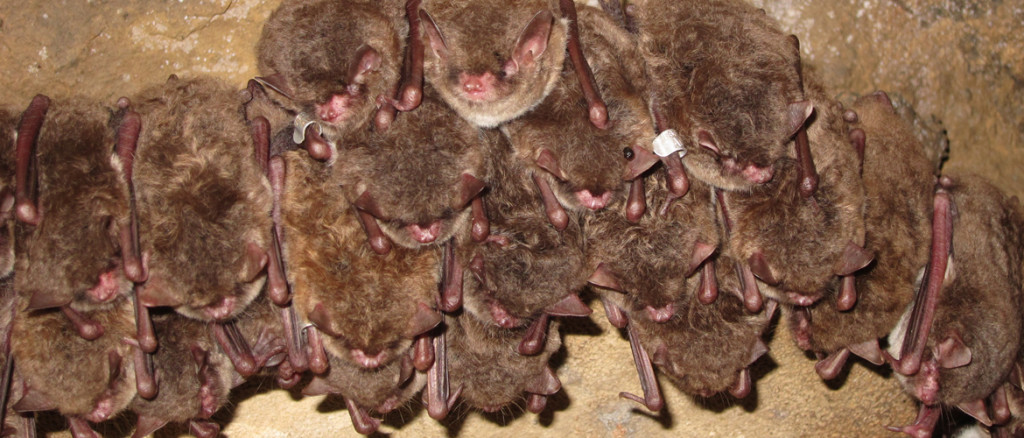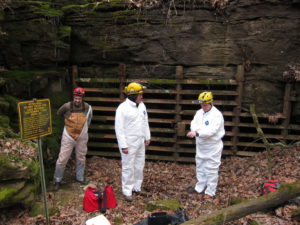
A cluster of Southeastern Bats in an Illinois hibernaculum. Two of the bats have aluminum wing bands, indicating they have previously been captured. A tick is visible on the ear of a bat adjacent to the wing band on the right-hand side of the image. Photo (c) SJTaylor.
On cold days like today, the bats of Illinois have to use special strategies to survive. While some bat species migrate to warmer habitats for the winter, many bats regularly hibernate in Illinois, and use this period of inactivity to survive the winter. At least six species regularly hibernate in Illinois, and others may to occasionally hibernate in the state. During hibernation, bats enter a period of dormancy and reduce their body temperature, metabolic rate, respiration, and heart rate. These reductions can be extreme- the heart rate of a little brown bat, Myotis lucifigus, can reach 1,300 beats/minute while flying in the summer, but during hibernation to as low as 20 beats/minute. In Illinois, hibernation often lasts from October or November until early April depending on the species cold tolerance and local climate.
While bat activity is greatly reduced during this period, bats are not constantly “asleep” during the winter. Hibernating bats, as with other hibernating mammals, will awaken ever so often throughout hibernation. While they typically do not feed during these periods of activity (primarily because their insect food source is absent), bats will fly, drink, or even move to different hibernation sites before returning to a state of inactivity.

Researchers prepare to enter a cave through a bat gat, to conduct a winter hibernaculum count. Photo by SJ Taylor.
Bat hibernation sites are known as hibernacula, and vary from species to species. Many species, including the little brown bat, Myotis lucifugus, and Indiana bat, Myotis sodalis, roost in large groups in caves and abandoned mines, mostly in the southern part of the state. Some Indiana bats hibernacula in Illinois may contain thousands of individuals of this endangered species. Other bat species, such as the tri-colored bat, Pipistrellus subflavus, also use caves as hibernacula, but hibernate singly or in small groups. Some bats may use above-ground structures as hibernacula- southeastern bats, Myotis austroriparius, and especially big brown bats, Eptesicus fuscus, regularly use hollow trees, buildings, attics, and bridges as hibernacula. The eastern red bat, Lasiurus borealis, has the most unique hibernation behavior — traveling south to hibernate in leaf litter on the forest floor in southern-most Illinois and elsewhere. For all of these overwintering bats, hibernacula provide important shelter from extremes of cold and protection from predators that might otherwise find inactive bats.
Protecting hibernacula is an important component of conservation of Illinois bats. By protecting caves, forests, and abandoned mines, important winter habitat for thousands of bats remains available for their use. Some cave and mine hibernacula are best protected from disturbance by constructing bat gates. These specialized gates are made of horizontal steel bars, which are far enough apart for bats to fly through, but prevent humans from entering. Continued research to enhance our understanding of bat hibernaculum use will continue to help us do a better job of conserving winter habitats which the bats need to survive Illinois winters. The Illinois Bat Conservation Program works with various management organizations to conduct winter surveys in select hibernacula to track population size and hibernaculum use over the years. Such data help state and federal agencies better understand bat population trends, and gauge impacts of the deadly bat disease, White Nose Syndrome, on bat populations.

